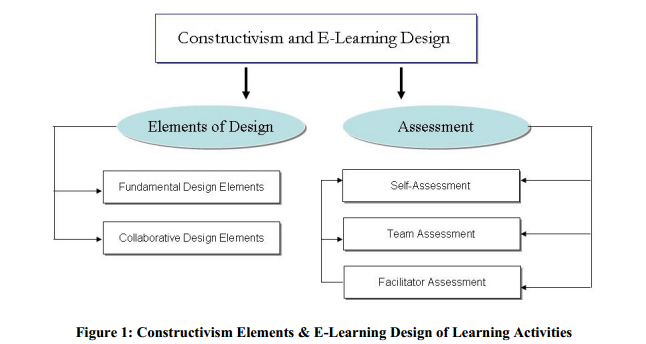Constructivist E-Learning – from Theory to Practice
 About the Sauce (Theory)
About the Sauce (Theory)
Research agrees that constructivism learning theory, which focuses on knowledge construction based on learner’s previous experience, is a good fit for e-learning because it ensures learning among learners (Koohang, Riley, Smith, & Schreurs, 2009).
About the Ingredients
Koohang (2009) as documented in Koohang et al. (2009) advanced a model based on constructivism learning theory in e-learning environments. The model includes three categories for elements of Constructivism:
- The Design of Learning Activities
- Learning Assessment
- Instructor’s Roles
The design of learning activities included collaboration, cooperation, multiple perspectives, real world examples, scaffolding, self-reflection, multiple representations of ideas, and social negotiation. The learning assessment elements consisted of instructor assessment, collaborative assessment, and self-assessment. The instructor’s roles were coaching, guiding, mentoring, acknowledging, providing feedback, and assessing student learning.
This diagram illustrates the model as developed by Koohang (2009) and documented in Koohang et al. (2009). The model is comprised of two categories: the learning design elements and learning assessment elements.
The learning design elements include fundamental design elements and collaborative design elements. The fundamental design elements are essential for designing learning activities. Koohang et al. (2009) tell us that they include the following nine elements:
- Conceptual interrelatedness and interdisciplinary learning
- Exploration
- Higher-order thinking skills
- Learner’s driven goals and objectives
- Learner’s own previous experiences
- Learner’s self-mediating and control of learning
- Learner’s self-reflection
- Real world and relevant examples
- Scaffolding that can be used to make learners think above and beyond what they normally know.
The learning assessment elements of the learner-centered model for designing e-learning assignments/activities include the following three elements:
Constructivist Ideas for Assessment
“process is as important as product” (Miller, P.H., 2002)
1. Anecdotal Records – ongoing assessment — observations
2. Celebration of Learning – students have the opportunity to share their expertise in several subject areas with other students, teachers and parents (i.e. student led conferences)
3. Exit Cards – An easy 5 minute activity to check student knowledge before, during and after a lesson or complete unit of study. Students respond to 3 questions posed by the teacher.
4. Graphic Organizers – Graphic organizers, also known as mind maps, are instructional tools used to illustrate prior knowledge.
5. Journals – Journals can be used to assess for process of learning and student growth. They can be open-ended or the teacher can provide guiding, reflective questions for the students to respond to.
6. Oral Presentations – Students are allowed to verbally share their knowledge. Some students may choose to do an oral presentation using multimedia.
7. Peer Assessment – Assessment in which one learner, groups of learners or the whole class gives written or verbal feedback to another learner. Peers can use checklists, rubrics or give a written response to peer work.
8. Portfolios – collection of an individual student’s work. A student portfolio is generally composed of best work to date and a few “works in progress” that demonstrate the process.
9. Project-Based Learning – instructional strategy that challenges students to discover answers to their questions through real-world investigation.
10. Rubrics – A rubric is “a road map, telling students and teachers where to begin, where they’re going, and how to get there.” Dr. Kay Burke
11. Simulation – role playing by the actors/activities; may include gaming
About how to mix it all together (Practice)
Below are some examples to demonstrate the application of constructivist theory in practice.
Social Constructivism: Games, Simulations, Cases, and Problem Solving
A framework for developing and implementing an online learning community
Let’s talk about this sauce and other sauces you’ve tried:
What do you think of the nine elements as presented by Koohang et al. (2009)? Do they fit with what you believe to important in the use of constructivistic theory in e-learning environments? Click here to respond in our Blackboard Discussion Forum.
Is making discussion forums a required activity a constructivist approach? Click here to respond in our Blackboard Discussion Forum.

